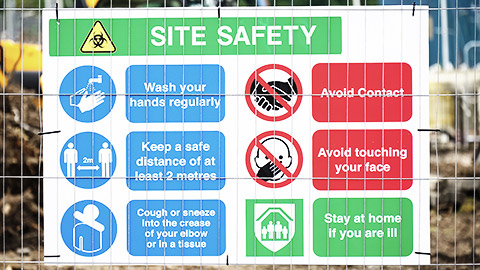In this section you will learn to:
- Develop and provide consultative WHS activities to provide advice in relation to work health and safety issues
- Monitor processes for ensuring that workers have an opportunity to contribute feedback on health and safety issues
- Document outcomes of consultation and communicate to workers
- Develop and implement processes to ensure that responsibilities and duties are documented and accountability processes are in place
- Implement and monitor training programs to ensure identified WHS training requirements are addressed, including induction process
Supplementary materials relevant to this section:
- Reading H: Sample WHS Consultation Procedures
- Reading I: Organising Health and Safety Training in your Workplace
Consultation is an important part of effective WHS processes. This section of the module is designed to help you understand the importance of consultation and how organisational management can facilitate consultation, cooperation, and communication in relation to WHS activities.

Under the WHS Act, the PCBU has a duty to consult their workers on WHS matters. They also have a duty to consult, cooperate, and coordinate activities with other duty holders (e.g., suppliers, contractors, and building owners) who may influence how work is carried out in the workplace. While the PCBU is the main person who holds this duty, the officers (e.g., managers, directors, coordinators) must exercise due diligence to ensure that these duties are fulfilled.
In practical terms, WHS consultation is a two-way communication process between PCBUs/officers and their workers with the intention of:
- Sharing relevant work health and safety information
- Providing workers with the opportunity to express their views and raise health and safety matters
- Enabling workers to contribute to the decision-making process relating to health and safety matters
- Taking into account the views of workers
- Advising workers of the outcome of any consultation in a timely manner.
(Safe Work Australia, 2022)
Consulting with workers can provide valuable information about hazards in the workplace and allows PCBUs/officers to make informed decisions about safe work practices. While consultation is a legal requirement, there are also additional benefits for conducting consultation. These include:
- Greater awareness and commitment – because workers who have been actively involved in how health and safety decisions are made will better understand the decisions
- Positive working relationships – because understanding the views of others leads to greater co-operation and trust
(Safe Work Australia, 2022. p. 9)
Although consultation may not always result in agreement, the organisation’s commitment to open communication regarding WHS matters will contribute to higher effectiveness and compliance with the decisions. Practical guidelines on consultation, cooperation, and coordination regarding WHS matters can be found in the Model Code of Practice available on Safe Work Australia website.
According to the guidelines from Safe Work Australia (2016), WHS consultation should take place when:
- identifying hazards and assessing risks arising from work
- proposing changes that may affect the health and safety of workers, and
- whenever specifically required to do so under particular regulations.
and when considering making decisions about:
- ways to eliminate or minimise risks
- the adequacy of facilities for workers’ welfare at work
- procedures for consulting with workers
- procedures for resolving health and safety issues
- procedures for monitoring the health of workers or workplace conditions, and
- how to provide health and safety information and training to workers.
(Safe Work Australia, 2016, p.15)
Understandably, there will be times when there is emergency WHS issues and it will not be possible to consult everyone. However, so far as reasonably practicable, there are two main categories of people who need to be consulted regarding WHS matters:
- Those who carry out work for the PCBU – workers or their representatives (i.e., Health and Safety Representatives or a Health and Safety Committee).
- Those who are (or likely to be) directly affected by these health and safety decisions (e.g., contractors and their workers, volunteers, clients, etc.)
Under WHS legislation, workers may request to nominate one or more workers to speak in their place on WHS matters. These workers will take on the role of Health and Safety Representative (HSR). To elect a HSR, work groups must first be established by grouping workers who share a similar work situation. For example, if your organisation provides services in multiple sites, workers who work at the same site can be considered as a work group as they are likely to face similar WHS issues. Work groups may also be established based on nature of work (e.g., outreach workers, administrative staff, etc.) or work hours and patterns (e.g., night shift, volunteer, part-time, etc.). If HSRs are elected in your organisation, you will be required to liaise with them while consulting on WHS matters.

In some organisations, a Health and Safety Committee (HSC) is also formed to “facilitate cooperation between a PCBU and workers in developing and carrying out measures to ensure health and safety at work” (Safe Work Australia, 2020, p. 6). The members of this committee will meet on a regular basis to discuss WHS matters and spend reasonable work time to carry out relevant duties. Where there is a HSC in your organisation, you will also need to consult and liaise with the committee to develop consultative WHS activities with workers.
Other than employees of your organisation, it is also important to consult with others who may be affected by the health and safety decisions made in your organisation (for example, other organisations/contractors conducting similar work in the same place). In the context of an allied health organisation, it may also be necessary to consult with volunteers and clients to ensure that their needs and concerns are being looked after (WorkSafe Victoria, 2006).
Self Reflection
Before reading on, take a moment to reflect on your workplace or a workplace that you are familiar with. Are workers consulted in regard to WHS matters? If so, how are workers being consulted?
There is no legal requirement as to how WHS consultation should take place, however, it is good practice for management to engage in discussions with workers to determine the most effective consultative activities for the organisation. The Code of Practice from Safe Work Australia (2022) recommends PCBUs/officers chose consultative activities that:
- Fulfil the duty to consult
- Ensure participation of all workers with consideration of part-time, shift or mobile workers
- Best integrate with the organisation’s management of WHS

If you were a PCBU/officer of a relatively small allied health organisation, you may be able to consult each of the workers directly. The consultative process could be formal (e.g., a WHS process review) or informal (e.g., catch up over morning tea), and either in a one-on-one, small group, or team meeting context. However, if the organisation is of medium or large size, consulting each worker directly may not be practical. In these cases, you would most likely consult the workers through their representatives – HSRs and/or HSCs – in regard to WHS matters.
It is good practice to provide workers and their representatives with relevant information about matters pertinent to their health and safety as early as possible. It is not only a legal requirement but also allows time for workers to consider and contribute to the discussions in an informed and constructive manner. Information that needs to be provided may include technical guidance about workplace hazards and risks, hazard reports and risk assessments, proposed changes to the workplace, data on incidents, illness or injuries and health and safety policies and procedures (Safe Work Australia, 2022).
Alternatively, WHS consultation can also be tailored to your organisation by establishing agreed consultation procedures with workers. Consultative activities may include:
- Informal catch up with workers
- Team meetings to talk about WHS matters
- Briefing sessions on new WHS policy and procedures
- Toolbox talks
- WHS newsletters or information sheets
- Suggestion box/email for workers to send suggestions about WHS matters
- Updating internet/intranet-based information regarding WHS
It is important to conduct regular consultation instead of simply leaving it to when issues arise so that WHS issues can be identified and resolved in the early stages. For greater efficiency, PCBUs/officers should consider integrating WHS consultation into regular discussions undertaken in the organisation instead of establishing separate WHS consultative meetings. For example, WHS can be incorporated as a standard agenda item of weekly team meetings. Some workplaces may also require a mix of consultative activities to meet the needs of different workers and situations. For example, a few workers who work at remote locations will be consulted directly while the rest of the workers will be consulted via their HSRs. Ultimately, the goal is to ensure workers are provided with reasonable opportunities to contribute feedback on health and safety issues and that their views are considered when making relevant decisions.
Reading
H – Sample WHS Consultation Procedures
Agreed procedures for WHS consultation should be documented in the WHS policy and procedures of the organisation and communicated to all workers. A template of a WHS consultation procedure is included in Reading H.
As you complete Reading H, attempt to find the following information:
- When does consultation occur? Who are being consulted?
- How are the consultation processes being carried out?
- What are the roles of workers and HSRs?
When developing WHS consultation procedures, PCBUs/officers should ensure that the procedures for consultation include information such as:
- the matters requiring consultation
- who will be consulted
- the ways consultation will occur, for example through regular meetings, toolbox talks or health and safety representatives
- how information will be shared with workers and health and safety representatives
- what opportunities will be provided for workers and health and safety representatives to give their views on proposed matters
- how consultation will occur with workers who have a disability, special language or literary needs
- how feedback will be given to workers and health and safety representatives, and
- timeframes for reviewing the procedures.
(Safe Work Australia, 2022. p. 21)
Safe Work Australia. (n.d.). How to manage work health and safety risks.
A Note on Barriers to Effective Consultation

As with all communication, you will come across barriers that prevent efficient consultation. The following extract provides some examples and tips regarding such barriers.
There are many barriers to how we communicate and consult with each other in the workplace. Finding the right time and delivering messages in the right way can be a challenge. Workers and HSRs should establish a relationship with their manager that encourages open and honest discussion and mutual trust. Consultation often fails due to:
- Lack of clarity of message
- Absence of emotional resonance in your message
- Inaccurate targeting
- Poor timing
- No genuine feedback process.
Tips to reduce barriers through communication:
- Engage people on an emotional level
- Provide clear messages with concrete examples to help people focus their energies
- Think about what you say and how you say it (is what you are saying aligned with what you are feeling and thinking?)
- Written material should be backed up by verbal communication
- Check the tone of the communication (edit, edit and edit again)
- Some news is better than no news
- Let people know the status of what is happening, you are the key in communicating change, workers look to you to see if there is real acceptance.
(Mining and Quarrying Occupational Health and Safety Committee, 2017)

Once consultation arrangements have been developed, they must be implemented and regularly reviewed in collaboration with workers and health and safety representatives. This is to ensure that the current consultation arrangements continue to be effective in fulfilling the duty to consult as well as in enabling workers to contribute feedback on health and safety issues.
There are a number of processes that can be used to review consultation arrangements, but one of the most common involves the use of compliance checklists. An example of a consultation compliance checklist provided by Safe Work Australia (2011, p. 23) is included below.
| Consultation compliance | Yes/No |
|---|---|
| Do I have one or more consultation arrangements in place after consultation with my workers? | |
| Do the consultation arrangements include workers other than my employees such as contractors or labour hire workers who are part of my workforce? | |
| Do I use my consultation mechanism when I: | |
|
|
|
|
|
|
|
|
|
|
| When I consult with my workers on these issues do I: | |
|
|
|
|
|
|
|
|
|
|
|
|
| If workers are represented by a health and safety representative, do I: | |
|
|
|
|
| Do I consult other duty holders who share responsibility for a health and safety matter with me? | |
|
Alternatively, PCBUs/officers may use effective consultation checklists (such as the example shown on the next page) to survey workers on the effectiveness of the consultation arrangements.
|
Effective Consultation in Your Workplace Effective consultation is mandatory under the WHS Act. You may find this checklist helpful. It is based on the WHS Consultation, Cooperation, and Coordination Code of Practice. |
|
| In your workplace, is consultation a two-way process between the PCBU and workers where they: | |
|
☐ |
|
☐ |
|
☐ |
| Are workers encouraged to: | |
|
☐ |
|
☐ |
|
☐ |
|
☐ |
| And: | |
|
☐ |
|
☐ |
|
☐ |
|
☐ |
|
☐ |
(Adapted from Courtenell Pty Ltd, 2013)
In order to encourage workers to express their views and contribute to health and safety decisions, PCBUs/officers should:
- Provide appropriate opportunities during work hours for consultation with workers with consideration of different work types (e.g., shift work, casual, contract, part-time etc.)
- Foster an environment of openness and encouragement by allowing opinions about health and safety to be regularly discussed and considered during workplace meetings
- Provide workers with various avenues for feedback such as email, setting up an intranet health and safety page, or a suggestion box
(Safe Work Australia, 2022)
It is also important to monitor the processes used to gather feedback from workers. If your organisation gathers feedback from workers using indirect avenues such as email, suggestion box, organisational intranets, and comment boxes, you should monitor both the quantity and quality of data received through these channels to determine their effectiveness. For example, you may want to work out which option is most effective for workers to provide feedback and the reasons behind it. Moreover, lack of confidentiality in the options provided would also discourage workers from giving their honest opinions. If there seems to be limited WHS feedback provided by workers, it may be necessary to review the options available and consider different approaches that are more engaging to workers or schedule meetings to prompt WHS discussion among workers.

PCBUs/officers should reflect upon all matters raised during consultation and take appropriate steps in light of this information. Once an issue has been identified and resolution has been agreed upon, it is important to notify workers as soon as possible, explaining the reasoning behind any decisions made/steps taken, and responding to any questions/concerns raised by workers. It is good practice to ensure that organisational policies and procedures document a specific timeframe for the resolution of issues and informing workers of the outcomes.
While documenting the outcomes of WHS consultation is only legally required in some cases, documenting outcomes is generally beneficial in supporting risk management processes and so should be done even when not legally required. By documenting the consultation process and outcomes, you are able to demonstrate the organisation’s adherence to relevant WHS legislations, decrease the likelihood of disputes, and facilitate the resolution process. Safe Work Australia (2022) proposes that records of consultation outcomes should include information of:
- What the safety matter is
- Who was identified as affected, or likely to be affected
- Who was involved in consultations
- What decision has been made
- Who is to take action and by when
- When the action has been completed
(Safe Work Australia, 2022, p.16)
It is very important to clearly document any actions that are required as a result of the consultation process, who is required to take this action, and when by. This helps ensure that responsibilities are documented and accountability processes are in place, which helps ensure that consultation outcomes are appropriately actioned.
It is also important to ensure that this information is communicated to workers. When communicating consultation outcomes to workers, it is important to present it in plain and simple language that takes into account the literacy needs and culturally and linguistically diverse (CALD) backgrounds of workers. Where possible, it may be beneficial to communicate the information through visual means, such as a diagram, in order to make it easier for workers to understand. The most effective and personable way of communicating the information is by meeting face-to-face with workers. However, this is not always preferable or possible and other forms of communication may need to be considered such as email, noticeboards, or the organisation’s intranet.
Through consultation with workers and their representatives, PCBUs/officers are able to obtain feedback about possible ways to manage the hazards and risks in the organisation. Consultation may also reveal the presence of work practices that are likely to cause accidents or injuries to workers or the presence of training gaps in workers. It is important to provide appropriate training to all workers so that they are aware of unsafe work practices and trained to conduct work in a safe and healthy manner.

All organisations in all states and territories of Australia must adhere to their relevant WHS legislation in regard to training workers in WHS matters. Under WHS legislation, it is mandatory to provide workers and their representatives with relevant information and training to ensure work health and safety.
Reading
I – Organising Health and Safety Training in Your Workplace
Reading I provides additional information on the different types of health and safety training. These opportunities may include formal training (e.g., courses or vocational training) or informal training (e.g., provided by a supervisor/experienced worker)
WHS is the responsibility of all workers, therefore WHS training must be provided to everyone in the organisation.
Depending on the workers’ role and responsibilities at work, their needs for training will differ. The following extract summarises some key considerations for organising WHS training.
Manager, supervisor and coordinator WHS training should include:
- Their roles and responsibilities
- Legislation
- Hazards and hazard management
- Conducting audits and incident investigation
- Resolution of WHS issues and the role of WHS inspectors
- Roles, responsibilities and rights of workers
- Injury management.
Worker (including volunteer) WHS training should include whatever knowledge and skills are needed for them to work safely. They should receive training:
- During induction
- Prior to commencing hazardous tasks they have not previously done
- Regularly as updates.
Training should include:
- Worker and management responsibilities
- Specific hazards e.g. manual tasks, electrical safety, hazardous substances
- Use of internal systems (hazard reporting, home safety checks, risk assessments and incident reporting).
In addition, specific training must be provided for Health and Safety Representatives (HSRs), WHS committee members, first aid officers, emergency control staff, WHS Coordinators and the Rehabilitation and Return-to-Work Coordinators (RRTWC).
(SafeWork South Australia, 2014, p.13)
To determine training needs, you should consult with workers and their representatives to obtain feedback about any training gaps within the organisation. If direct consultation is not practical, you may utilise tools such as surveys or checklists to help identify the health and safety training needs for workers. Examples of these are included in Reading I.
Once gaps are identified, you will need to plan appropriate training activities to meet identified needs. It is important that the training is flexible to the varying needs and skill levels of workers. Consideration should be given to shift employees, part-time, and casual employees when scheduling training time to ensure participation. If necessary, WHS information and training should also be provided to workers in languages other than English. When effective training is provided, workers are more likely to actively monitor and evaluate the way work is done, thereby creating a safer work culture.
It is also important to ensure that all officers and managers to have appropriate, high-level WHS training because they play a significant role in setting safety standards in the workplace. Indeed, under WHS legislation, officers are required to remain up-to-date with WHS matters relevant to their workplace.
Once WHS training programs are implemented, it is also important to keep records of the training provided. These records can be used to keep track of what training has been provided and to document that the organisation has fulfilled its training requirements. Of course, it is also important to monitor the effectiveness of the training provided to ensure that workers’ needs are met. To do this you may ask workers to complete a short evaluation survey or provide verbal feedback regarding the training provided and its appropriateness for their workplace needs. This can help reveal if any changes or additional training is required. It is also important to note that the procedures for assessing training needs should be repeated regularly to ensure continued safe work practices.
A Note on Induction Training

Work health and safety should be an integral part of induction training provided to all new workers (including full-time, part-time, casual, contract, and volunteer) as well as contractors on site. WorkSafe Victoria (2006) suggests that content of the induction training should cover the following information:
- Workplace hazards
- Risk control measures
- WHS management systems
- Health and safety procedures
- Contact information for health and safety representatives
- First aiders
- Fire wardens
- How to access health and safety information
Part of the induction training should include explaining to new workers the processes involved in reporting incidents and discussing safety issues in the organisation. For example, some organisations require workers to report WHS matters to their direct line supervisor or a HSR. Other organisations also have designated persons that workers can raise specific WHS issues with, such as First Aid Officers, Fire Wardens, or Anti-bullying representatives. It is important that new workers are made aware of these designated persons during induction and that they are also documented in WHS policies and procedures.
During the induction process, it is good practice for managers or supervisors to use a checklist to ensure key WHS information is covered. An example of an induction checklist that includes WHS information is provided below.
| Worker Name: _____________________________ | Employment Date: ____________________________ |
| Position/Job: ______________________________ | Manager/Supervisor: _________________________ |
| GENERAL INDUCTION | |
|---|---|
| Introduction (explain) ☐ Nature and structure of the organisation Employment conditions (explain) ☐ Job description and responsibilities ☐ Work times and meal breaks ☐ Time recording procedures ☐ Leave entitlements ☐ Notification of sick leave or absences ☐ Out-of-hours enquiries and emergency procedures Meet key people (introduce) ☐ Health and Safety Representatives ☐ Payroll officers/human resources staff ☐ Co-workers Other issues ☐ Quality management policy and procedures ☐ Environmental management policy and procedures ☐ Equal employment opportunity ☐ Sexual harassment ☐ View driver’s license Security ☐ Car parking ☐ Client home security ☐ Personal /personal belongings ☐ Cash/ drugs ☐ Emergency procedures |
Payroll (explain) ☐ Rates of pay and allowances ☐ Pay arrangements ☐ Taxation (including completing the required forms) ☐ Superannuation and any other deductions ☐ Union (membership) and award conditions Health and safety (explain and show) ☐ WHS policy and procedures ☐ Roles and responsibilities for health and safety ☐ Information and hazards present in client homes and controls ☐ Role and names of Health and Safety Representative/ Health and Safety Committee ☐ Health and safety communication processes ☐ Incident reporting procedures, including the location of forms that need tbe completed ☐ Emergency procedures, including emergency exists and equipment, and first aid ☐ Safe use and storage of hazardous chemicals, including Safety Data Sheets |
| Review ☐ Review work practices and procedures with the worker ☐ Answer and ask questions ☐ Repeat any training required or provide additional training if needed |
|
| Conducted by (name): ________________________ (sign): ____________________ Date: __________________ Worker’s signature: _______________________________________________________ Date: __________________ |
|
(SafeWork SA, 2014, p.66)
In some organisations, new workers are even required to complete a short test with multiple choice answers at the end of their induction to document their understanding of WHS procedures. While this is not a legislative requirement, it is good practice to check-in with new workers to ensure that they understand the WHS information that they have been provided with. This can also be an opportunity to obtain feedback to help with continuous improvement processes, as it is important to regularly review and evaluate induction procedures to ensure that training systems are meeting the needs of workers of various roles and skill levels. Ultimately, induction training records should also be kept as evidence of WHS risk management within the organisation.
Next watch an example of an WH&S Induction from people2people.
Consultation is a vital aspect of effective WHS. It helps ensure that WHS processes meet the needs of workers and that workers are engaged with WHS processes. In this section of the module, you learned about some of the most common practices involved in WHS consultation.
